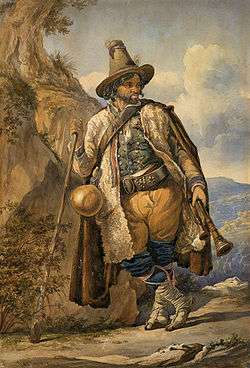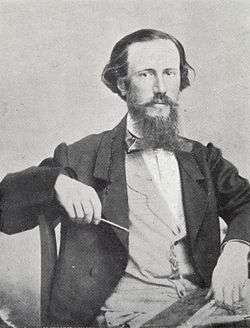Arthur John Strutt
| Arthur John Strutt | |
|---|---|
|
Portrait of Arthur John Strutt | |
| Born |
1819 Chelmsford |
| Died |
1888 Rome |
| Nationality | British |
| Known for | Painter, engraver, Campagna Romana |

 Two women in the Roman theatre of Tusculum, pencil drawing by Arthur John Strutt, 1859 |
Arthur John Strutt (Chelmsford, 1819 – Rome, 1888),[1] was an English painter, engraver, writer, traveller and archaeologist. He was the son of the landscape painter Jacob George Strutt (1790–1864) and the writer and traveller Elizabeth Strutt.
After travelling across Italy, in 1831, in retinue of his father, he moved to Rome, where he definitively established his residence. He travelled with his father in France and Switzerland from 1835 to 1837, and later in Italy.[2]
In 1841 he travelled on foot through central and southern Italy and in Sicily. He and his friend, the poet William Jackson, otherwise unknown, started from the Porta San Giovanni of Rome on 30 April 1841, reaching Palermo on 15 December, and arriving back at Rome in July of the following year. An account of this journey is given in his A Pedestrian Tour in Calabria & Sicily published in London, in 1842.[3]
In 1849 Arthur John Strutt and his father had a studio at 52, via del Babuino, an address found both in the Roman Advertiser and, for Mrs. Strutt, in the address-book of Elizabeth Barrett Browning.[4] In 1853 his studio was at 33, via del Mercede; he is described as "a very clever painter of landscapes and Roman costumes, and author of an interesting work on Calabria".[5] In 1869 his studio was at 20, via di S. Basilio, and the description reads: "a very clever painter of landscapes, scenery about Rome, and groups of Roman peasantry and cattle; he has produced some large subjects of the Campagna, of its aqueducts, and the scenery along the Via Appia ... he is the author of an interesting work on Calabria".[6] In 1881 the address is 81, via della Croce, and the description largely unchanged.[7]
Art works
Many of his paintings are of subjects from the Campagna Romana. A celebrated one depicts a meet of the Roman Hunt with King Umberto I.[2] His sketchbooks are in the Huntington Library in San Marino, California.[8]
Archaeology
From 1881 until his death in 1888 Strutt was an honorary inspector of antiquities at Lanuvium, on the recommendation of Rodolfo Lanciani; he was made an honorary citizen of the modern town of Lanuvio and elected to the Consiglio comunale or town council.[9] His descriptions of Latin inscriptions in the area were published in the scientific periodical Notizie degli scavi di antichità of the Reale Accademia dei Lincei[10] and elsewhere.[11]
Published works
- A Pedestrian Tour in Calabria & Sicily London: T.C. Newby 1842 Full text on archive.org, on Google Books
- Guido Puccio (ed.) Calabria Sicilia 1840 Naples: Edizioni scientifiche italiane 1970
Strutt became editor of the weekly Roman Advertiser, the first English-language paper of Italy, in succession to the founding editor, the Irish antiquary Charles Isidore Hemans (1817–1876).[12] 106 issues of The Roman Advertiser: Journal of Science, Literature and the Fine Arts appeared between 24 October 1846 and 21 April 1849;[13] it was published on Saturday evenings by the Monaldini bookshop at 79, Piazza di Spagna, and cost 5 baiocchi.[14]
External links
| Wikimedia Commons has media related to Arthur John Strutt. |
References
- ↑ Strutt, Arthur John Union List of Artist Names Full Record Display ID:500026653
- 1 2 Bryan, Michael, George Charles Williamson (1903–05) Bryan's Dictionary of Painters and Engravers London: G. Bell, Volume 5, S–Z, p.138
- ↑ Review of A Pedestrian Journey in Calabria and Sicily in: The Churchman; a monthly magazine in defence of the venerable Church and constitution of England Volume VIII. London:Painter 1843 p. 351
- ↑ Elizabeth Barrett Browning, Arabella Barrett, Scott Lewis (ed.) (2002) The letters of Elizabeth Barrett Browning to her sister Arabella: in two volumes Waco, TX: Wedgestone Press ISBN 978-0-911459-29-6 pp.147–148
- ↑ [Blewitt, Octavian] (1853) A Handbook for Travellers in Central Italy; Part II, Rome and its environs ... Third edition [of the work originally written by Octavian Blewitt], carefully revised and augmented London: John Murray p.225
- ↑ [s.n.] (1869) A Handbook of Rome and its environs; Ninth edition, carefully revised on the spot to the latest period, with a large plan of Rome, a map of the environs, etc. London: John Murray p.xlv
- ↑ [s.n.] (1881) A Handbook of Rome and its environs; with more than 50 plans and maps of the city and environs. Thirteenth edition. London: John Murray p.22
- ↑ Theodore E. Stebbins (ed.), William H. Gerdts (1992) The lure of Italy: American artists and the Italian experience, 1760–1914 Houston: Museum of Fine Arts ISBN 978-0-8109-3561-7 p.279
- ↑ Arthur John Strutt Archived 2 April 2012 at the Wayback Machine. Associazione Culturale Lanuvionline. Accessed September 2011
- ↑ Attenni, Luca, Daniele F. Maras (2004) 'Materiali arcaici dalla collezione Dionigi di Lanuvio ed il più antico alfabetario latino', in Studi Etruschi mmIV – Vol. LXX [SERIE III] ISSN 0391-7762 pp.61–77
- ↑ Dressel, Heinrich (1966)Corpus inscriptionum latinarum: inscriptiones urbis romae latinae (in Latin) Berlin: Walter de Gruyter Volume XV, part 1
- ↑ Spada, Giuseppe Storia della rivoluzione di Roma e della restaurazione del governo pontificio dal 1 giugno 1846 al 15 luglio 1849 (in Italian) Firenze: G. Pellas 1868 "History of the revolution of Rome and the restoration of the Papal government from 1 June 1846 to 15 July 1849" Volume 1, p.324
- ↑ Annuario dell'Istituto storico italiano per l'età moderna e contemporanea Istituto storico italiano per l'età moderna e contemporanea. Bologna: Nicola Zanichelli Editore 1936, Volume 1 p.130
- ↑ 'XIV. Things of the day', in The Artizan, Third series 1: II, 1 February 1847
